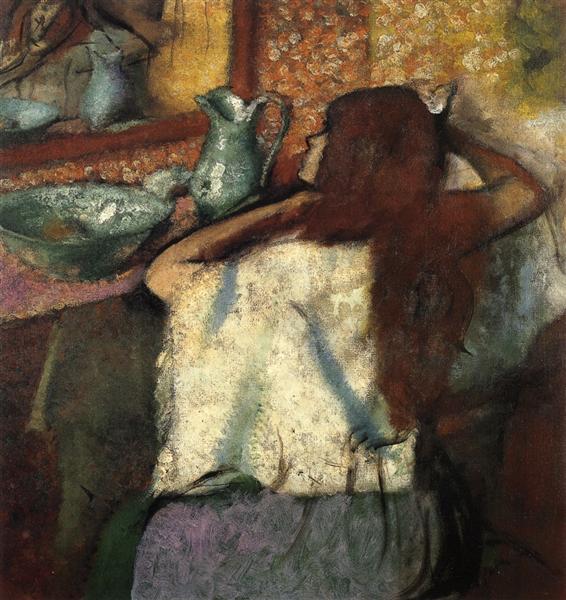Descrição
Edgar Degas' painting "Woman at Her Bath" (1900) is a work that encapsulates the artist's mastery in depicting the human body and female intimacy. An innovator of the Impressionist movement, Degas often focused his attention on everyday life and domestic tasks, using his compositions to delve into the psychology of his subjects. In "Woman at Her Bath," Degas manages to create an intimate moment that evokes both the fragility and strength of the female experience.
In the composition of the work, the central figure of the woman captured in the middle of her grooming routine is in a relaxed, almost unaware posture. The loose and vibrant application of paint allows the viewer's gaze to slide over the woman's body, highlighting the sensuality of her forms with a focus on the naturalness of the moment. The figure, which appears in profile and slightly leaning, is positioned against a background that contrasts with her illuminated and soft skin.
The colour palette used by Degas is rich and subtle, characterised by warm skin tones, accentuated by the reflections of the bathroom and splashes of colour in the surroundings. Light plays a crucial role in the work; the treatment of luminosity highlights both the figure and the objects around it, creating an enveloping atmosphere. The earthy colours, the creamy whites of the towel and the subtle shadows suggest an intimate and personal space.
A fascinating aspect of this painting is the way in which Degas moves away from the idealisation that was common in academic art of his time. Rather than offering a glamorous view of the female nude, the work reflects an authenticity that is characteristic of Degas' approach, highlighting the everyday life of the woman in her bath. This approach is also present in other works by Degas, where he often portrayed women in domestic contexts, such as in his depictions of dancers and washerwomen.
The choice to depict the woman in such a personal moment suggests an invitation to the viewer to contemplate not only the physical beauty of the figure, but also her humanity. Degas used the female figure as a vehicle to explore profound themes of identity, vulnerability and self-determination. The study of movement and posture reveals his interest in the anatomy and elegance of the human body, inscribed in an everyday narrative that transcends the momentary.
It is notable that Degas, despite being primarily recognized for his work with dance and ballet, extensively explored the theme of female intimacy in his work. "Woman at Her Bath" is a perfect example of this exploration, encapsulating the artist's ability to capture moments in life that, though ephemeral, possess enduring emotional depth.
In conclusion, Edgar Degas's "Woman at Her Bath" is not just a depiction of a woman in a private moment; it is an invitation to examine the complexity of daily life and the beauty inherent in simplicity. The work demonstrates Degas' mastery in capturing the light, form, and essence of his subjects, elevating the mundane to a state of sublime art. It is a testament not only to his technical skill, but also to his deep understanding of the human experience.
KUADROS ©, a famous painting on your wall.
Hand-made oil painting reproductions, with the quality of professional artists and the distinctive seal of KUADROS ©.
Painting reproduction service with satisfaction guarantee. If you are not completely satisfied with the replica of your painting, we will refund 100% of your money.

